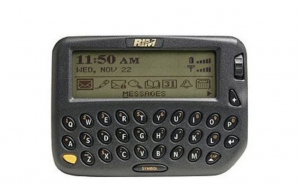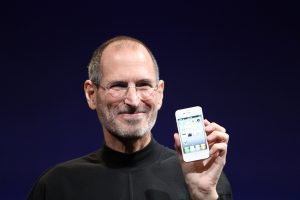27 Smartphone
Dylan Rudzinski
27.1 Introduction
Keywords
- Smartphone– a computer and a mobile device in one
- Personal digital assistant (PDA)– a mobile device that functions as a personal information manager
- Dopamine– a neurotransmitter that is responsible for human motivation and happiness
- Melatonin-a hormone produced by our body that stimulates sleep
Learning Objectives
- Understand the history and development of the smartphone.
- Become aware of the impact smartphones have on our lives.
- Recognize the pros and cons of smartphone use.
- Develop insight on the future of smartphone development.
27.2 Background
Key Takeaway
A smartphone is simply a computer and a mobile device all in one. In the 90s, computers were getting smaller, and battery technology was improving. This allowed many companies to begin experimenting with creating smartphones. However, at the time, smartphones would retail for extremely high prices. Because of the high prices, not a lot of people owned smartphones. Smartphones were originally marketed towards wealthier business professionals to ease their communication. As they became cheaper to produce, everyday consumers began to purchase them.
The first ever smartphone, The Simon Personal Communicator, was developed by IBM in 1992. It was made available for sale in 1994 for $1100. It featured 11 built-in PDA applications. A PDA application is essentially our present day apps for our smartphones. The PDAs included a calendar, appointment scheduler, to-do list, world time clock, and electronic notepad. It was also the first phone to feature a touch screen. The SPC only had 1 hour of battery life. It was large, bulky, and heavy. IBM only sold around 50,000 units before discontinuing the product a year later. The SPC would act as a base for other companies to begin producing their own innovative smartphones.
It wasn’t until 1999 that the Blackberry 850 was released. The Blackberry 850 was the first smartphone to feature emails on the go. It had an instant messaging system. Year over year, Blackberry would continue to produce updated and improved versions of the 850. However, one of the biggest issues with the Blackberry phone was its physical keyboard below the screen. The keys were tiny. Many complained about the keys becoming loose and not working overtime. Other major complaints included how slow it was, and the low resolution screen.

“Black Berry 850” by ZDNET is in used with permission from the IT History Society (ITHS)
Case Study: A Groundbreaking Reveal
In 2007, Apple revealed the iPhone during the yearly Macworld event. Apple’s CEO Steve Jobs announced a device that was a “widescreen iPod with touch controls” and a “revolutionary mobile phone.” Apple combined all of the technology featured in their iPod, which was a small hand held touch screen audio player, into a phone. The iPhone battery life allowed for 8 hours of call time and 250 hours of standby. Apple’s iPhone in 2007 was a monumental step in the development of smartphones. When the iPhone came out, it was years ahead of the competing smartphones in the market. It was the first to remove the physical keyboard and use a multi gesture touch screen. The iPhone not only featured email, messaging, and agenda but also featured a wide range of new applications never seen on a phone before. 14 years later, Apple is now the largest company in the world. They continue to produce innovative smartphones year over year.

“Steve Jobs shows off iPhone 4 at the 2010 Worldwide Developers Conference” by Matthew Yohe is licensed under CC BY-SA 3.0
27.3 Impact on Society
Key Takeaway
The smartphone has changed the way we communicate forever. With that being said, the downsides have potentially outweighed the benefits.
According to a study conducted by Flurry, the average American consumer spends 5 hours per day on their smartphone. Additionally, according to a Baylor University study, college female students spend up to 10 hours on their smartphones. These metrics do not include work related smartphone usage. With over 2.5 billion people around the globe owning smartphones (Silver, 2019), their impact on society is very substantial.
Smartphones have drastically changed the way we communicate and interact with each other. They allow us to connect with one another through email, text, or social media, without ever having to talk in person. They also give us instant access to emergency lines. Additionally, they give us instant access to live up-to-date world news. Smartphones have given us the ability to broaden our social circle, increase our closeness with others, and increase social interaction. Smartphones have also allowed people with social anxiety or isolation to socialize comfortably. Smartphones compensate for those with lack of a social network offline. Through social media, texting, e-mail, facetime, and calling, smartphones allow us to communicate from anywhere, anytime, with anyone. With all of that being said, smartphones have also brought with them some serious negative effects.
The negative effects can be mostly identified from our younger generation. They have grown up using smartphones. The Monitoring the Future survey asks 8-12th graders how happy they are, and how they spend their leisure time. According to the survey, there is a direct correlation between smartphone usage and overall happiness levels in teenagers (Twenge, 2017). The survey has also found that teens who use smartphones at higher rates are significantly more likely to experience loneliness, depression, and a higher risk of suicide. 48 percent more teenage girls say they feel left out in 2015 than in 2010. With smartphones, teens are easily made aware of social gatherings that they are missing out on, leading to them feeling left out and lonely. Because of the time spent on smartphones, our younger generation has also become more likely to put off responsibilities like getting a job, a driver’s license, and doing homework.
The most recognizable impact of smartphones on our everyday life is how they affect our ongoing physical and mental tasks. For example, texting while driving. Texting while driving leads to less attention on the road, slower response times, and ultimately more car crashes. Smartphone usage has significantly affected our brain’s rewards processing system, our productivity, and our quality of sleep. They have also impacted our attention span and ability to multitask. Studies have shown that even the mere presence of a smartphone will affect your cognitive performance (Wilmer et al., 2017). Smartphones have provided us with an unlimited supply of social stimuli, which releases dopamine in our brains. Our brains naturally crave easier hits of dopamine. Every time someone receives a notification on their phone, whether it’s a text, Snapchat, or Instagram like, it’s very easy to get distracted from what they are doing. According to a 2021 survey conducted by the Pew Research Center, 85% of Americans have a smartphone. With that many Americans carrying smartphones, it has severely impacted our society’s productivity. The blue-light emitted from smartphones suppresses the production of melatonin. One of the most commonly cited reasons for insufficient sleep is smartphone usage (Lemola et al., 2014).
27.4 THE FUTURE
Key Takeaway
The smartphone still has lots of room to improve and develop upon.
The near future for smartphones is very simple. Smartphones will become faster, more energy efficient, cheaper, and lighter. Phones will be thinner, and potentially bendable. Companies will also begin experimenting with holograms. Additionally, the camera quality on smartphones will continue to achieve new heights. Competing companies will continue to make new and improved phones to satisfy consumer wants.
The long term future outlook for smartphones will be a transition to a more wearable technology. For example, the Apple watch, or Facebook’s (now known as Meta) smart glasses that are in development. However, that is just the beginning of this transition. Smartphones may evolve to become a part of our bodies. The future smartphone could be a bio-electronic device. It could be some sort of chip implant that will connect our consciousness to the internet. Instead of having to carry around a phone with us, we will be the phone, powered by our own body chemistry.

“Processor Brain Head” by geralt is under a Pixabay license
Chapter Summary
The smartphone has been one of our generation’s most disruptive technologies. Starting with the IBM Simon Personal Communicator, to now the iPhone 13, it’s come a long way. It has allowed us to all connect and communicate with each other wherever and whenever we want. With that being said, the smartphone has also brought with it some serious negative effects on our physical and mental health. Teens are depressed and lonely at alarmingly high rates, society has become lazier, and people cannot put their smartphones down.
Review Questions
Review Questions
1. Which of the following was a major complaint of the Blackberry 850?
A. It was too large.
B. The keys on the keyboard broke easily.
C. It had a very low battery life.
D. The touch screen was not responsive.
2. Which of the following are not negative effects of the smartphone?
A. Ease of communication
B. Depression among teens
C. Losing sleep
D. Decreased productivity
3. Why was the iPhone such a game changer for the smartphone industry?
A. It was the first phone with a touch screen.
B. It had the largest battery life ever on a smartphone.
C. It was the first smartphone ever.
D. It featured a multi gesture touch screen allowing them to remove the physical keyboard.
4. How many hours do you spend a day on your smartphone?
5. Do you think your smartphone affects your productivity?
Answers
1. B
2. B
3. A
References
Ceci, L. (2021, October 19). Time spent on average on a smartphone in the U.S. 2021. Statista. https://www.statista.com/statistics/1224510/time-spent-per-day-on-smartphone-us/.
Duke, E., & Montag, C. Smartphone addiction, daily interruptions and self-reported productivity. ScienceDirect. https://www-sciencedirect-com.libproxy.clemson.edu/science/article/pii/S2352853217300159.
Goodrich, T. (2014, August 27). Cellphone addiction is ‘an increasingly realistic possibility,’ Baylor Study of college students reveals. Media and Public Relations | Baylor University. https://www.baylor.edu/mediacommunications/news.php?action=story&story=145864
IPhone 1 – Steve Jobs Macworld keynote in 2007 – Youtube. https://www.youtube.com/watch?v=VQKMoT-6XSg.
Lanaj, K., Johnson, R. E., & Barnes, C. M. (2014, February 20). Beginning the workday yet already depleted? Consequences of late-night smartphone use and sleep. Organizational Behavior and Human Decision Processes. https://www.sciencedirect.com/science/article/pii/S0749597814000089#b0060.
Odgers, C. (2018, February 21). Smartphones are bad for some teens, not all. Nature News. https://www.nature.com/articles/d41586-018-02109-8?report=reader.
On the Origin of the Smartphone. Product evolution. (2018, March 12). https://www.productevolution.org/2018/03/on-the-origin-of-the-smartphone/.
Pew Research Center. (2021, April 26). Mobile Fact Sheet. Pew Research Center: Internet, Science & Tech. https://www.pewresearch.org/internet/fact-sheet/mobile/.
Twenge, J. M. Have smartphones destroyed a generation? The Atlantic. http://www.postgrowth.ca/uploads/8/4/9/4/84946882/have_smartphones_destroyed_a_generation.pdf.
Want, R., & Islam, N. Smartphones: Past, present, and future. IEEE. https://ieeexplore.ieee.org/abstract/document/6926722.
Wilmer, H. H., Sherman, L. E., & Chein, J. M. (2017, April 25). Smartphones and cognition: A review of research exploring the links between mobile technology habits and cognitive functioning. Frontiers in psychology. https://www.ncbi.nlm.nih.gov/pmc/articles/PMC5403814/.
A mobile device that functions as a personal information manager.
A neurotransmitter that is responsible for human motivation and happiness.
A hormone produced by our body that stimulates sleep.

